MP7
| Location: Walpeup | Northcote Factual Key: Db 1.53 |
| General Landscape Description: Upper slope of a gentle rise known as the Limestone Site within the Mid Mallee Land System. | Australian Soil Classification: Endohypersodic, Regolithic, Hypocalcic CALCAROSOL |
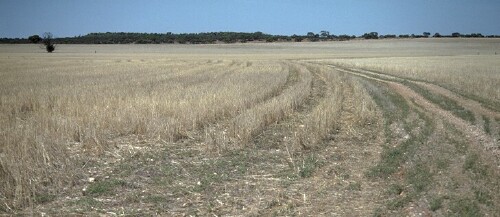 MP7 Landscape |
Soil Profile Morphology:
Surface Soil
| A1 | 0-5 cm | Dark brown (7.5YR3/4); sandy loam; hardsetting surface condition with calcrete coarse fragments common (10-20%); structure; weak consistence dry; highly calcareous; pH 8.3; sharp and wavy change to: | 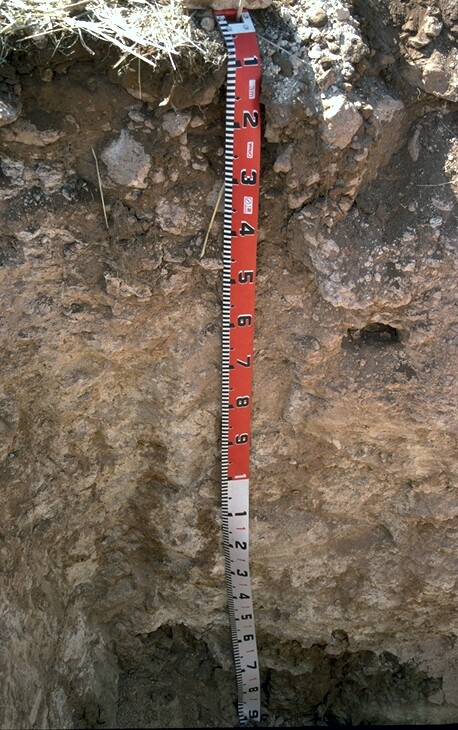 MP7 Profile |
| Subsoil | |||
| B2 | 5-30 cm | Dark red (2.5YR3/6); light sandy clay loam; firm consistence dry; pH 8.4; highly calcareous; clear and tongued change to: | |
| C1 | 30-90 cm | Yellowish red (7.5YR6/6); light clay; firm consistence dry; contains very many (>50%) hard carbonates; very highly calcareous: | |
| C2 | 90-145 cm | Yellowish red (5YR5/8); light clay; very firm consistence dry; contains very many (>50%) soft carbonates; moderately calcareous; pH 9.4: | |
| 2B2 | 145+ cm | Pale olive (5Y6/3) with sub-dominant brown (7.5YR4/4); heavy clay; strong very coarse prismatic, parting to strong coarse prismatic structure; strong consistence moist; contains few (2-10%) manganiferous material; moderately calcareous; pH 8.7 Note: This horizon may be equivalent to Blanchetown Clay (Jim Rowan pers. com.). | |
- Hardsetting, sandy and shallow surface soil.
- High calcium levels and moderate inherent fertility beneficial to plant growth.
- Calcrete layers containing high carbonates starting at 30 cm depth.
- Blanchtown Clay layer at 145+ cm.
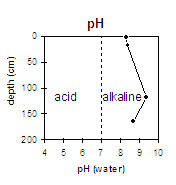 | 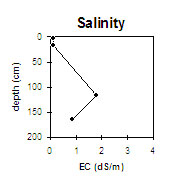 |
| The soil profile is moderately alkaline to 1 metre. Then becomes very strongly alkaline. | |
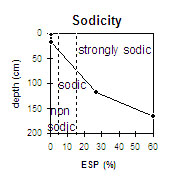 | 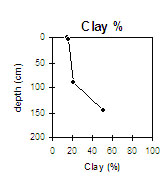 |
| The surface and upper subsoil is non-sodic. The deeper subsoil is strongly sodic. | The clay content increases gradually with depth and is quite high in the deeper subsoil. |
Management Considerations:
Whole Profile
- The high calcium levels in this soil will aid the already moderate inherent fertility beneficial for plant growth and help to increase soil aggregation.
Surface (A) Horizons
- The surface soil is shallow, has a high sand content (ie. 74%) and is hardsetting when dry. Soils such as these rely to a large extent on organic matter for maintaining aggregation. The organic carbon levels at this pit site are moderate (which may or may not be representative of the whole paddock) and will build up under pasture but will decline if cultivation takes place. Practices such as residue retention, minimum tillage and including pasture rotations could be utilised if cropping takes place in order to build up organic matter, increase soil fertility, aggregation and water holding capacity.
- The levels of total nitrogen measured at this pit site is moderate which is very good for this region. However, this is best assessed by taking a bulked sample from across the paddock.
Subsoil (B) Horizons
- Soluble salt levels increase markedly in the high calcrete layers of the subsoil. If plant roots manage to penetrate these layers, then the salt levels may restrict the growth of salt sensitive species (e.g. faba beans, chickpeas, lupins).
- The subsoil is very strongly alkaline at about 80 cm depth. This indicates that some nutrients (e.g. manganese, zinc, iron, copper) may be poorly available to deep rooted species.
- The subsoil below 80 cm depth becomes strongly sodic. Slight dispersion occurs as a result restricting root and water movement, however, with the increase of salt levels going down the profile the dispersion decreases accordinglyThe Blanchtown Clay at 145 cm is very high in sodium (15.9 meq/100g) and is reported to have had boron collected in this layer (pers. com. Jim Rowan). Water movement is very slow within the range of 50-200 mm per year. Reportedly, cereals are more favourable to this soil than lupins.
Profile Described By: Profile described by Mark Imhof, Jim Rowan and Sonia Thompson (March 1994).


